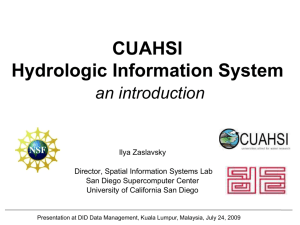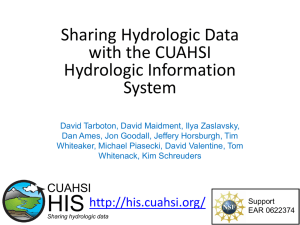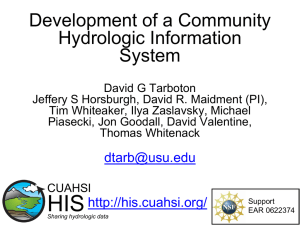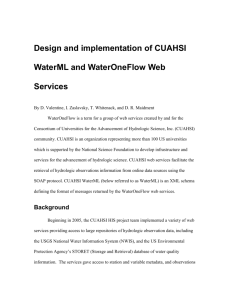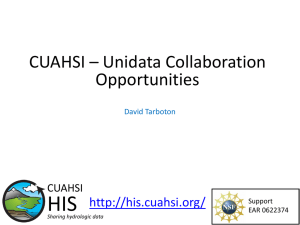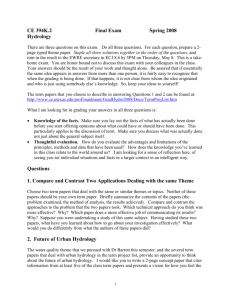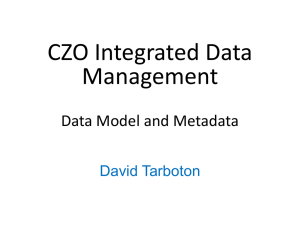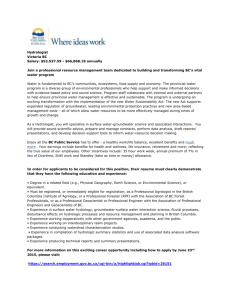CUAHSIHIS
advertisement
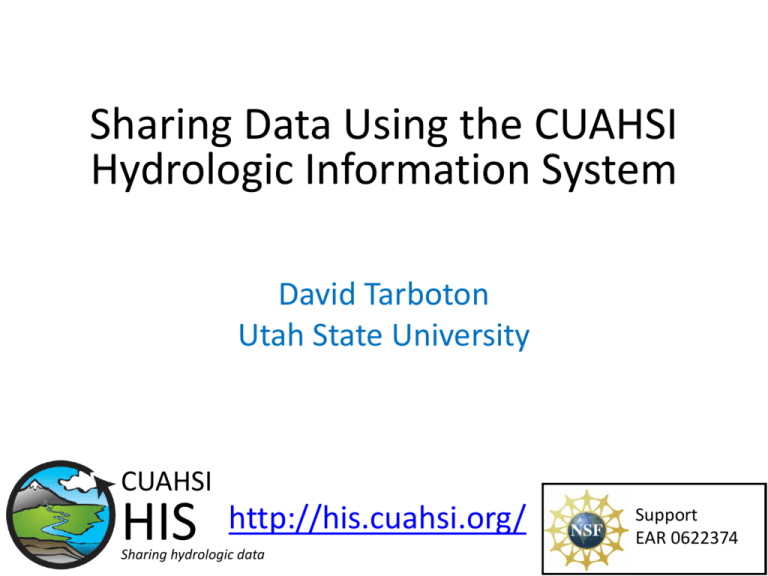
Sharing Data Using the CUAHSI
Hydrologic Information System
David Tarboton
Utah State University
CUAHSI
HIS
http://his.cuahsi.org/
Sharing hydrologic data
Support
EAR 0622374
The CUAHSI Hydrologic Information
System Team
•
•
•
•
•
•
•
•
•
University of Texas at Austin – David Maidment, Tim Whiteaker, James Seppi,
Fernando Salas, Jingqi Dong, Harish Sangireddy
San Diego Supercomputer Center – Ilya Zaslavsky, David Valentine, Tom Whitenack,
Matt Rodriguez
Utah State University – David Tarboton, Jeff Horsburgh, Kim Schreuders, Stephanie
Reeder
University of South Carolina – Jon Goodall, Anthony Castronova
Idaho State University – Dan Ames, Ted Dunsford, Jiří Kadlec, Yang Cao, Dinesh Grover
Drexel University/CUNY – Michael Piasecki
CUAHSI Program Office – Rick Hooper, Yoori Choi, Jennifer Arrigo, Conrad Matiuk
ESRI – Dean Djokic, Zichuan Ye
Users Committee – Kathleen Mckee, Jim Nelson, Stephen Brown, Lucy Marshall, Chris
Graham, Marian Muste
CUAHSI
HIS
http://his.cuahsi.org/
Sharing hydrologic data
Support
EAR 0622374
What is CUAHSI?
Consortium of Universities for the Advancement of Hydrologic Science, Inc.
• 111 US University members
• 7 affiliate members
• 17 International affiliate members
(as of October 2011)
Infrastructure and services for the
advancement of hydrologic science and
education in the U.S.
http://www.cuahsi.org/
Support
EAR 0753521
CUAHSI HIS
The CUAHSI Hydrologic Information System (HIS) is an internet based system to support the
sharing of hydrologic data. It is comprised of hydrologic databases and servers connected
through web services as well as software for data publication, discovery and access.
HydroServer – Data Publication
HydroCatalog
Data Discovery
Lake Powell Inflow and Storage
HydroDesktop – Data Access and Analysis
HydroDesktop – Combining multiple data sources
Hydrologic Data
Challenges
• From dispersed federal
agencies
• From investigators collected
for different purposes
• Different formats
–
–
–
–
–
Points
Lines
Polygons
Fields
Time Series
Data Heterogeneity
Water quality
Water quantity
Rainfall and
Meteorology
Soil water
GIS
Groundwater
The way that data is organized can
enhance or inhibit the analysis that
can be done
I have your information
right here …
Picture from: http://initsspace.com/
Hydrologic Science
It is as important to represent hydrologic environments precisely with
data as it is to represent hydrologic processes with equations
Physical laws and principles
(Mass, momentum, energy, chemistry)
Hydrologic Process Science
(Equations, simulation models, prediction)
Hydrologic conditions
(Fluxes, flows, concentrations)
Hydrologic Information Science
(Observations, data models, visualization
Hydrologic environment
(Physical earth)
Data models capture the complexity of natural systems
NetCDF (Unidata) - A model for
Continuous Space-Time data
ArcHydro – A model for
Discrete Space-Time Data
Time, TSDateTime
Time, T
Coordinate
dimensions
{X}
TSValue
D
Space, FeatureID
Space, L
Variables, TSTypeID
Variables, V
Variable dimensions
{Y}
Terrain Flow Data Model used to enrich the
information content of a digital elevation model
CUAHSI Observations Data Model: What are the
basic attributes to be associated with each single
data value and how can these best be organized?
Data Searching – What we used to have to do
Searching each data source separately
NWIS
request
return
request
return
request
return
NAWQA
request
return
NAM-12
request
return
request
return
request
return
request
return
NARR
Michael Piasecki
Drexel University
What HIS enables
Searching all data sources
collectively
GetValues
GetValues
NWIS
GetValues
generic
request
GetValues
GetValues
GetValues
NAWQA
Michael Piasecki
Drexel University
GetValues
GetValues
NARR
ODM
Web Paradigm
Catalog
(Google)
Web Server
(CNN.com)
Access
Browser
(Firefox)
CUAHSI Hydrologic Information System
Services-Oriented Architecture
HydroCatalog
Data Discovery and
Integration
WaterML,
Other OGC
Standards
HydroServer
Data Publication
ODM
Data Services
HydroDesktop
Data Analysis and
Synthesis
Geo Data
Information Model and Community Support Infrastructure
Video Demo
http://his.cuahsi.org/movies/JacobsWellSpring/JacobsWellSpring.html
What are the basic attributes to be
associated with each single data value and
how can these best be organized?
Value
Offset
DateTime
Variable
OffsetType/
Reference Point
Location
Units
Source/Organization
Interval
(support)
Accuracy
Data Qualifying
Comments
Censoring
Method
Quality Control
Level
Sample Medium
Value Type
Data Type
CUAHSI Observations Data Model
Streamflow
Groundwater
levels
• A relational database at the
single observation level
Precipitation
Soil
(atomic model)
& Climate
moisture
• Stores observation data
data
made at points
Flux tower
Water Quality
• Metadata for unambiguous
data
interpretation
• Traceable heritage from raw
“When” Time, T
measurements to usable
t
A data value
information
vi (s,t)
• Standard format for data
s “Where”
sharing
Space, S
• Cross dimension retrieval
Vi
and analysis
“What”
Variables, V
Data Storage – Relational Database
Values
Sites
Value
Date
Site
Variable
Value
Name
Date
Site
Name
Latitude
Longitude
Latitude
Site Variable
Longitude
4.5 Cane3/3/2007
Creek 41.1
1
Streamflow
-103.2
Site
Name
Latitude
Longitude
4.2 Cane3/4/2007
Creek 41.1
1
Streamflow
-103.2
1
Cane Creek
41.1
-103.2
33 Town3/3/2007
Lake 40.3
2
Temperature
-103.3
2
Town Lake
40.3
-103.3
34 Town3/4/2007
Lake 40.3
2
Temperature
-103.3
Simple Intro to “What Is a Relational Database”
CUAHSI Observations Data Model http://his.cuahsi.org/odmdatabases.html
Horsburgh, J. S., D. G. Tarboton, D. R. Maidment and I. Zaslavsky, (2008), A Relational Model for
Environmental and Water Resources Data, Water Resour. Res., 44: W05406, doi:10.1029/2007WR006392.
Discharge, Stage, Concentration
and Daily Average Example
Site Attributes
SiteCode, e.g. NWIS:10109000
SiteName, e.g. Logan River Near Logan, UT
Latitude, Longitude Geographic coordinates of site
LatLongDatum Spatial reference system of latitude and longitude
Elevation_m Elevation of the site
VerticalDatum Datum of the site elevation
Local X, Local Y Local coordinates of site
LocalProjection Spatial reference system of local coordinates
PosAccuracy_m Positional Accuracy
State, e.g. Utah
County, e.g. Cache
Independent of, but can be coupled to
Geographic Representation
e.g. Arc Hydro
ODM
Feature
Observations Data Model
Sites
SiteID
SiteCode
SiteName
Latitude
Longitude
…
!(
1
1
OR
HydroID
HydroCode
FType
Name
JunctionID
CouplingTable
SiteID
1
HydroID
(!
!(
HydroID
!(
!(
!(
!(
Name
AreaSqKm
JunctionID
!( *
ComplexEdgeFeature
!(
!(
1
HydroEdge
!(
(!
!(
HydroID
HydroCode
ReachCode
Name
!( !(
LengthKm
LengthDown
FlowDir
!( FType
!( !(
EdgeType
!( Enabled
!(
!(
!((!
(!(!
Flowline
Shoreline
!(
!(
!(
*
!(
!( (!
!(
!(
HydroNetwork
!(
!( !(
!(
!(
!(
!(
!(
!(
EdgeType
!(
DrainID
!(
!(
AreaSqKm
JunctionID
!(
NextDownID
SimpleJunctionFeature
1
!( !(!(
Watershed
!((! HydroID
!(
(!(
!(! !( HydroCode
!(
!( HydroCode
FType
!(!(
*
!(
!(
Waterbody
HydroPoint
HydroJunction
(!
HydroID
!( !(
HydroCode
NextDownID
LengthDown
DrainArea
FType
Enabled
AncillaryRole
(!
1
!(
!(
!(
!( !(
!(
Stage and Streamflow Example
ValueAccuracy
A numeric value that quantifies measurement accuracy
defined as the nearness of a measurement to the
standard or true value. This may be quantified as an
average or root mean square error relative to the true
value. Since the true value is not known this may should
be estimated based on knowledge of the method and
measurement instrument. Accuracy is distinct from
precision which quantifies reproducibility, but does not
refer to the standard or true value.
ValueAccuracy
Accurate
Low Accuracy
Low Accuracy,
but precise
Water Chemistry from a profile in a lake
Loading data into ODM
OD Data Loader
• Interactive OD Data Loader (OD
Loader)
– Loads data from spreadsheets and
comma separated tables in simple
format
SDL
• Scheduled Data Loader (SDL)
– Loads data from datalogger files on a
prescribed schedule.
– Interactive configuration
• SQL Server Integration Services
(SSIS)
– Microsoft application accompanying
SQL Server useful for programming
complex loading or data
management functions
SSIS
3
Work
from Out
to In
5
7
At last …
1
2
6
And don’t
forget …
4
CUAHSI Observations Data Model
http://www.cuahsi.org/his/odm.html
Importance of the Observations Data
Model
• Provides a common persistence model for
observations data
• Syntactic consistency (File types and formats)
• Semantic consistency
– Language for observation attributes (structural)
– Language to encode observation attribute values (contextual)
• Publishing and sharing research data
• Metadata to facilitate unambiguous interpretation
• Enhance analysis capability
26
WaterML and WaterOneFlow
WaterML is an XML language for communicating water data
WaterOneFlow is a set of web services based on WaterML
• Set of query functions
GetSites
GetSiteInfo
GetVariableInfo
GetValues
WaterOneFlow
Web Service
• Returns data in WaterML
WaterML as a Web Language
USGS Streamflow data in WaterML language
Discharge of the San
Marcos River at Luling, TX
June 28 - July 18, 2002
This is the WaterML GetValues response from NWIS Daily Values
Open Geospatial Consortium
Web Service Standards
• Map Services
These standards have been
developed over the past 10 years ….
…. by 400 companies and agencies
working within the OGC
• Observation Services
• Web Map Service (WMS)
• Observations and
Measurements Model
• Web Feature Service (WFS)
• Sensor Web Enablement
• Web Coverage Service
(SWE)
(WCS)
• Catalog Services for the Web • Sensor Observation Service
(SOS)
(CS/W)
OGC Hydrology Domain Working Group evolving WaterML into an International Standard
http://www.opengeospatial.org/projects/groups/waterml2.0swg
Sensor Observations Service: Get Observation
Observed Property := “Wind_Speed“
Result
Feature of Interest
23 m/s
Sampling Time
16.9.2010 13:45
uom
Procedure (ID := “DAVIS_123“)
Observation
HydroServer – Data Publication
Point Observations Data
Internet Applications
Ongoing Data Collection
Historical Data Files
ODM
Database
GIS Data
GetSites
GetSiteInfo
GetVariableInfo
GetValues
WaterML
WaterOneFlow
Web Service
OGC Spatial
Data Service
from ArcGIS
Server
Data presentation, visualization,
and analysis through Internet
enabled applications
HydroCatalog
• Search over data services
from multiple sources
Service Registry
Hydrotagger
• Supports concept based
data discovery
WaterML
GetSites
GetSiteInfo
GetVariableInfo
GetValues
WaterOneFlow
Web Service
Harvester
Water Metadata
Catalog
Search Services
Discovery and Access
CUAHSI
Data
Server
Hydro
Desktop
3rd Party
Server
e.g. USGS
http://hiscentral.cuahsi.org
Overcoming Semantic Heterogeneity
• ODM Controlled
Vocabulary System
– ODM CV central database
– Online submission and editing
of CV terms
– Web services for broadcasting
CVs
Variable Name
Investigator 1:
Investigator 2:
Investigator 3:
Investigator 4:
“Temperature, water”
“Water Temperature”
“Temperature”
“Temp.”
ODM VariableNameCV
Term
…
Sunshine duration
Temperature
Turbidity
…
From Jeff Horsburgh
Dynamic controlled vocabulary moderation system
ODM Data
Manager
ODM
Website
ODM
Tools
XML
Local ODM
Database
Local
Server
ODM Controlled
Vocabulary Moderator
ODM
Controlled
Vocabulary
Web Services
http://his.cuahsi.org/mastercvreg.html
Master ODM
Controlled
Vocabulary
From Jeff Horsburgh
HydroDesktop – Data Access and Analysis
Integration from
multiple sources
Thematic
keyword
search
Search on
space and
time domain
HydroModeler
An integrated modeling environment based on the Open Modeling Interface
(OpenMI) standard and embedded within HydroDesktop
Allows for the linking of
data and models as “plugand-play” components
In development at the University of South Carolina by Jon Goodall, Tony
Castronova, Mehmet Ercan, Mostafa Elag, and Shirani Fuller
Integration with “R” Statistics Package
37 Water Data Services on HIS Central from 12
Universities
• University of Maryland,
Baltimore County
• Montana State University
• University of Texas at
Austin
• University of Iowa
• Utah State University
• University of Florida
• University of New Mexico
• University of Idaho
• Boise State University
• University of Texas at
Arlington
• University of California,
San Diego
• Idaho State University
Dry Creek Experimental Watershed (DCEW)
(28 km2 semi-arid steep topography, Boise Front)
68 Sites
24 Variables
4,700,000+ values
Published by Jim
McNamara, Boise
State University
Water Agencies and Industry
• USGS, NCDC , Corps of Engineers
publishing data using HIS WaterML
• OGC Hydrology Domain Working
Group evaluating WaterML as OGC
standard
• ESRI using CUAHSI model in
ArcGIS.com GIS data collaboration
portal
• Kisters WISKI support for WaterML
data publication
• Australian Water Resources
Information System Water Accounting
System has adopted aspects of HIS
• NWS West Gulf River Forecast Center
Multi-sensor Precipitation Estimate
published from ODM using WaterML
CUAHSI Water Data Services Catalog
69 public services
18,000 variables
1.9 million sites
23 million series
5.1 billion data values
(as of June 2011)
The largest water data
catalog in the world
maintained at the San Diego
40
Supercomputer Center
Open Development Model
• http://hydrodesktop.codeplex.com
• http://hydroserver.codeplex.com
• http://hydrocatalog.codeplex.com
Summary
• Data Storage in an Observations Data Model (ODM) and
publication through HydroServer
• Data Access through internet-based Water Data Services
using a consistent data language, called WaterML from
HydroDesktop
• Data Discovery through a National Water Metadata
Catalog and thematic keyword search system at Central
HydroCatalog (SDSC)
• Integrated Modeling and Analysis within HydroDesktop
This approach based on standards provides a general
foundation and approach for integration and sharing of
hydrologic data around the world.
Are there any questions ?
